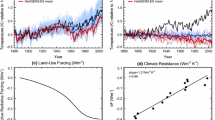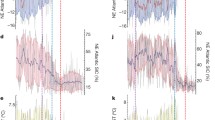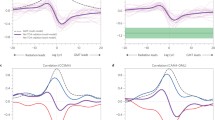Abstract
We present further steps in our analysis of the early anthropogenic hypothesis (Ruddiman, Clim Change 61:261–293, 2003) that increased levels of greenhouse gases in the current interglacial, compared to lower levels in previous interglacials, were initiated by early agricultural activities, and that these increases caused a warming of climate long before the industrial era (∼1750). These steps include updating observations of greenhouse gas and climate trends from earlier interglacials, reviewing recent estimates of greenhouse gas emissions from early agriculture, and describing a simulation by a climate model with a dynamic ocean forced by the low levels of greenhouse gases typical of previous interglacials in order to gauge the magnitude of the climate change for an inferred (natural) low greenhouse gas level relative to a high present day level. We conduct two time slice (equilibrium) simulations using present day orbital forcing and two levels of greenhouse gas forcing: the estimated low (natural) levels of previous interglacials, and the high levels of the present (control). By comparing the former to the latter, we estimate how much colder the climate would be without the combined greenhouse gas forcing of the early agriculture era (inferred from differences between this interglacial and previous interglacials) and the industrial era (the period since ∼1750). With the low greenhouse gas levels, the global average surface temperature is 2.7 K lower than present day—ranging from ∼2 K lower in the tropics to 4–8 K lower in polar regions. These changes are large, and larger than those reported in a pre-industrial (∼1750) simulation with this model, because the imposed low greenhouse gas levels (CH4 = 450 ppb, CO2 = 240 ppm) are lower than both pre-industrial (CH4 = 760 ppb, CO2 = 280 ppm) and modern control (CH4 = 1,714 ppb, CO2 = 355 ppm) values. The area of year-round snowcover is larger, as found in our previous simulations and some other modeling studies, indicating that a state of incipient glaciation would exist given the current configuration of earth’s orbit (reduced insolation in northern hemisphere summer) and the imposed low levels of greenhouse gases. We include comparisons of these snowcover maps with known locations of earlier glacial inception and with locations of twentieth century glaciers and ice caps. In two earlier studies, we used climate models consisting of atmosphere, land surface, and a shallow mixed-layer ocean (Ruddiman et al., Quat Sci Rev 25:1–10, 2005; Vavrus et al., Quat Sci Rev 27:1410–1425, 2008). Here, we replaced the mixed-layer ocean with a complete dynamic ocean. While the simulated climate of the atmosphere and the surface with this improved model configuration is similar to our earlier results (Vavrus et al., Quat Sci Rev 27:1410–1425, 2008), the added information from the full dynamical ocean is of particular interest. The global and vertically-averaged ocean temperature is 1.25 K lower, the area of sea ice is larger, and there is less upwelling in the Southern Ocean. From these results, we infer that natural ocean feedbacks could have amplified the greenhouse gas changes initiated by early agriculture and possibly account for an additional increment of CO2 increase beyond that attributed directly to early agricultural, as proposed by Ruddiman (Rev Geophys 45:RG4001, 2007). However, a full test of the early anthropogenic hypothesis will require additional observations and simulations with models that include ocean and land carbon cycles and other refinements elaborated herein.
Similar content being viewed by others
References
Anderson RF, Ali S, Bradtmiller L, Nielsen S, Fleisher M, Anderson B, Burckle L (2009) Wind-driven upwelling in the Southern Ocean and the deglacial rise in atmospheric CO2. Science 323:1443–1447
Andrews JT, Mahaffy MAW (1976) Growth rate of the Laurentide ice sheet and sea level lowering (with emphasis on the 115,000 BP sea level lows). Quat Res 6:167–183
Berger A (1978) Long-term variations of caloric insolation resulting from the Earth’s orbital elements. Quat Res 9:139–167
Berger A, Loutre MF (2002) An exceptionally long interglacial ahead? Science 297:1287–1288
Birchfield GE, Weertman J, Lunde AT (1982) A model study of the role of high-latitude topography in the climatic response to orbital insolation anomalies. J Atmos Sci 39:71–87
Briegleb BP, Bitz CM, Hunke EC, Lipscomb WH, Holland MM, Schramm JL, Moritz RE (2004) Scientific description of the sea ice component of the Community Climate System Model, Version Three. Tech. Rep. NCAR/TN-463+STR, National Center for Atmospheric Research, Boulder, CO, 78 pp
Brigham-Grette J, Hopkins DM, Ivanov VF, Basilyan AE, Benson SL, Heiser P, Pushkar VS (2001) Late interglacial (isotope stage 5) glacial and sea-level history of coastal Chukotka Peninsula and St. Lawrence Island, Western Berginia. Quat Sci Rev 20:419–436
Broecker WS, Stocker TL (2006) The Holocene CO2 rise: anthropogenic or natural? EOS Trans Am Geophys Union 87:27
Collins WD, Bitz CM, Blackmon ML, Bonan GB, Bretherton CS, Carton JA, Chang P, Doney SC, Hack JJ, Henderson TB, Kiehl JT, Large WG, McKenna DS, Santer BD, Smith RD (2006) The community climate system model: CCSM3. J Climate 19:2122–2143
Crucifix M, Berger AL (2006) How long will our interglacial be? EOS 87:352–353
Dickinson RE, Oleson KW, Bonan G, Hoffman F, Thornton P, Vertenstein M, Yang Z-L, Zeng X (2006) The community land model and its climate statistics as a component of the community climate system model. J Climate 19:2302–2324
Dyke AS, Prest VK (1987) Late Wisconsin and holocene history of the laurentide ice sheet. Géogr Phys Quat 41:237–263
Dyurgerov MB, Meier MF (2005) Glaciers and the changing climate system: a 2004 snapshot. Institute of Arctic and Alpine Research Occasional Paper 58:117
Flint RF (1943) Growth of North American ice sheet during the Wisconsin age. Geol Soc Amer Bull 54:325–362
Francois R et al (1997) Contribution of Southern ocean surface-water stratification to low atmospheric CO2 concentrations during the last glacial period. Nature 389:929–935
Gent PR, Bryan FO, Danabasoglu G, Lindsay K, Tsumune D, Hecht MW, Doney SC (2006) Ocean chlorofluorocarbon and heat uptake during the 20th century in the CCSM3. J Climate 19:2366–2381
Govin A, Michel E, Labeyrie L, Waelbroeck C, Dewilde F, Jansen E (2009) Evidence for northward expansion of Antarctic Bottom water mass in the Southern Ocean during the last glacial inception. Paleoceanography 24:PA1202. doi:10.1029/2008PA001603
Hansen J, Sato MKI, Ruedy R, Nazarenko L, Lacis A, Schmidt G, Russell G, 38 co-authors (2005) Efficacy of climate forcings. J Geophys Res 110:D18104. doi:10.1029/2005JD005776
Hays JD, Imbrie J, Shackleton N (1976) Variations in the earth’s orbit: pacemaker of the ice ages. Science 194:1121–1132
Holland MM, Bitz CM, Hunke EC, Lipscomb WH, Schramm JL (2006) Influence of the sea ice thickness distribution on polar climate in CCSM3. J Climate 19:2398–2414
IPCC (2007) Summary for policymakers. In: Solomon S, Qin D, Manning M, Chen D, Marquis M, Averyt KB, Tignor M, Miller HL (eds) Climate change 2007: the physical science basis. Contribution of working group 1 to the fourth assessment report of the intergovernmental panel on climate change. Cambridge University Press, Cambridge, United Kingdom and New York, NY, USA
Jones PD, Mann ME (2004) Climate over past millennia. Rev Geophys 42:RG2002. doi:10.1029/2003RG000143
Joos F, Gerber S, Prentice IC, Otto-Bleisner BL, Valdes P (2004) Transient simulations of Holocene atmospheric carbon dioxide and terrestrial carbon since the last glacial maximum. Glob Biogeochem Cycles 18:GB2002. doi:10.1029/2003GB002156
Jouzel J, Lorius C, Petit JR, Genthon C, Barkov NJ, Kotlyakov VM, Petrov VN (1990) Vostok ice core: a continuous isotope temperature record over the last climatic cycle (160,000 years). Nature 329:403–409
Jouzel J et al (2007) Orbital and millennial Antarctic climate variability over the past 800,000 years. Science 317:793–797
Karabanov EB, Prokopenko AA, Williams DF, Colman SM (1998) Evidence from Lake Baikal for Siberian Glaciation during oxygen isotope substage 5d. Quat Res 50:46–55
Kaufman DS, Manley WF, Forman SL, Layer PW (2001) Pre–late-Wisconsin glacial history, coastal Ahklun Mountains, southwestern Alaska—new amino acid, thermoluminescence and 40Ar/39Ar results. Quat Sci Rev 20:337–352
Keeling RF, Visbeck M (2001) Antarctic stratification and glacial CO2. Nature 412:605–606
Kiehl JT, Shields CA, Hack JJ, Collins WD (2006) The climate sensitivity of the Community Climate System Model:CCSM3. J Climate 19:2584–2596
Kutzbach J, Williams J, Vavrus S (2005) Simulated 21st century changes in regional water balance of the Great Lakes region and links to changes in global temperature and poleward moisture transport. Geophys Res Lett 32:L17707. doi:10.1029/2005GL023506
Lisiecki LE, Raymo ME (2005) A Plio-Pleistocene stack of 57 globally distributed benthic δ18O records. Paleoceanography 20:PA1003. doi:10.1029/2004PA001071
Loulergue L et al (2008) Orbital and millennial-scale features of atmospheric CH4 over the past 800,000 years. Nature 453:383–386. doi:10.1038/nature06950
Luthi D et al (2008) High-resolution carbon dioxide concentration record 650,000-benthic δ18O records. Paleoceanography 20:PA1003. doi:10.1029/2004PA001071 (800,000 years before present. Nature 453:379–382. doi:10.1038/nature06949)
Manabe S, Stouffer R (1980) Sensitivity of a global climate model to an increase of CO2 concentration in the atmosphere. J Geophys Res 85:5529–5554
Martin P, Archer D, Lea DW (2005) Role of deep sea temperatures in the carbon cycle during the last glacial. Paleoceanography 20:PA2015. doi:10.1029/2003PA000914
Meehl G, Washington W, Wigley T, Arblaster J, Dai A (2003) Solar and greenhouse gas forcing and climate response in the twentieth century. J Climate 16:426–444
Mysak L (2008) Glacial inceptions: past and future. Atmos-Ocean 46:317–341. doi:10.3137/ao.460303
Oerlemans J (2005) Extracting a climate signal from 169 glacier records. Science 308:675–677
Olofsson J, Hickler T (2008) Effects of human land-use on the global carbon cycle during the last 6,000 years. Veg Hist Archaeobot 17:605–615. doi:10.1007/s00334-07-0126-6
Otto-Bliesner BL, Tomas R, Brady EC, Ammann C, Kothavala Z (2006a) Climate sensitivity of moderate- and low-resolution versions of CCSM3 to preindustrial forcings. J Climate 19:2567–2583
Otto-Bliesner BL, Brady EC, Clauzet G, Tomas R, Levis S, Kothavala Z (2006b) Last glacial maximum and Holocene climate in CCSM3. J Climate 19:2527–2544
Pierce KL (2004) Pliestocene glaciations of the Rocky Mountains. In: Gillespie AR et al (eds) The quaternary period in the United States: developments in quaternary science, vol 1. Elsevier, Amsterdam, pp 63–76
Ruddiman WF (2003) The anthropogenic greenhouse era began thousands of years ago. Clim Change 61:261–293
Ruddiman WF (2005) Cold climate during the closest stage 11 analog to recent millennia. Quat Sci Rev 24:1111–1121
Ruddiman WF (2007) The early anthropogenic hypothesis: challenges and responses. Rev Geophys 45:RG4001. doi:10.1029/2006RG000207
Ruddiman WF (2008) The challenge of modeling interglacial CO2 and CH4 trends. Quat Sci Rev 27:445–448
Ruddiman WF, Vavrus SJ, Kutzbach JE (2005) Test of the ‘overdue-glaciation’ hypothesis. Quat Sci Rev 25:1–10
Sedlacek J, Mysak LA (2008a) A model study of the Little Ice Age and beyond: changes in ocean heat content, hydrography, and circulation. Clim Dyn 33(4):461–475. doi:10.1007/s00382-008-0503-6
Sedlacek J, Mysak LA (2008b) Sensitivity of sea ice to wind stress and radiative forcing since 1500: a model study of the Little Ice Age and beyond. Clim Dyn 32(6):817–831. doi:10.10007/s00382-008-0406-6
Shin S, Liu Z, Otto-Bliesner BL, Kutzbach JE, Vavrus SJ (2003) Southern Ocean sea-ice control of the glacial North Atlantic thermohaline circulation. Geophys Res Lett 30(2):1096. doi:10.1029/2002GL015513
Stephens BB, Keeling RF (2000) The influence of Antarctic sea ice on glacial/interglacial CO2 variations. Nature 404:171–174
Stouffer RJ, Manabe S (2003) Equilibrium response of thermohaline circulation to large changes in atmospheric CO2 concentration. Clim Dyn 20:759–773
Toggweiler JR (2009) Shifting westerlies. Science 323:1434–1435
Toggweiler JR, Russell JL, Carlson SR (2006) Midlatitude westerlies, atmospheric CO2, and climate change during the ice ages. Paleoceanography 21. doi:10.1029/2005PA001154
Vavrus SJ, Ruddiman WF, Kutzbach JE (2008) Climate model tests of the anthropogenic influence on greenhouse-induced climate change: the role of early human agriculture, industrialization, and vegetation feedbacks. Quat Sci Rev 27:1410–1425
Vettoretti G, Peltier WR (2004) Sensitivity of glacial inception to orbital and greenhouse gas climate forcing. Quat Sci Rev 23:499–519
Wang Z, Mysak LA, McManus JF (2002) Response of the thermohaline circulation to cold climates. Paleoceanography 17(1):1006
Wang Y, Roulet N, Frolking S, Mysak LA (2009) The importance of northern peatlands in the global carbon systems during the Holocene. Clim Past Discuss 5(2):1231–1258
Williams LD (1978) The little ice age glaciation level on Baffin Island, Canada. Palaeogeogr Palaeoclimatol Palaeoecol 25:199–207
Author information
Authors and Affiliations
Corresponding author
Rights and permissions
About this article
Cite this article
Kutzbach, J.E., Ruddiman, W.F., Vavrus, S.J. et al. Climate model simulation of anthropogenic influence on greenhouse-induced climate change (early agriculture to modern): the role of ocean feedbacks. Climatic Change 99, 351–381 (2010). https://doi.org/10.1007/s10584-009-9684-1
Received:
Accepted:
Published:
Issue Date:
DOI: https://doi.org/10.1007/s10584-009-9684-1




